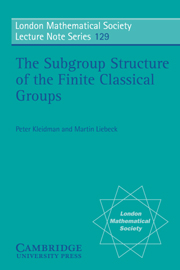Book contents
- Frontmatter
- Preface
- Standard notation and terminology
- Contents
- Chapter 1 Motivation and Setting for the Results
- Chapter 2 Basic Properties of the Classical Groups
- Chapter 3 The Statement of the Main Theorem
- Chapter 4 The Structure and Conjugacy of the Members of C
- Chapter 5 Properties of the Finite Simple Groups
- Chapter 6 Non-maximal Subgroups in C: the Examples
- Chapter 7 Determining the Maximality of Members of C, Part I
- Chapter 8 Determining the Maximality of Members C, Part II
- References
- Index of notation
- Index
Preface
Published online by Cambridge University Press: 19 February 2010
- Frontmatter
- Preface
- Standard notation and terminology
- Contents
- Chapter 1 Motivation and Setting for the Results
- Chapter 2 Basic Properties of the Classical Groups
- Chapter 3 The Statement of the Main Theorem
- Chapter 4 The Structure and Conjugacy of the Members of C
- Chapter 5 Properties of the Finite Simple Groups
- Chapter 6 Non-maximal Subgroups in C: the Examples
- Chapter 7 Determining the Maximality of Members of C, Part I
- Chapter 8 Determining the Maximality of Members C, Part II
- References
- Index of notation
- Index
Summary
Following the classification of the finite simple groups, completed in 1980, one of the major areas of research in group theory today is the investigation of the subgroups of the finite simple groups, and in particular, the determination of their maximal subgroups. According to the classification theorem, the finite simple groups fall into four classes:
the alternating groups An (n ≥ 5);
the finite classical groups — that is, the linear, symplectic, unitary and
orthogonal groups on finite vector spaces;
the exceptional groups of Lie type;
the 26 sporadic groups.
In this book we concentrate on the classical groups, which we describe in detail in Chapter 2. Our work takes as its starting point the fundamental results of M. Aschbacher in [As1]. Let G be a finite classical group. In [As1], Aschbacher introduces a large collection C(G) of natural, geometrically defined subgroups of G, and shows that almost every subgroup of G is contained in a member of C(G) (the precise result is stated in Chapter 1). Thus the collection C(G) of subgroups plays a central role in the theory of classical groups. This book is intended to be a definitive investigation of the collection C(G). In it, we solve the three main problems concerning these subgroups — namely, we determine
(I) the group-theoretic structure of each member of C(G),
(II) the conjugacy among the members of C(G),
(III) precisely which members of C(G) are maximal in G and which are not — and, for non-maximal members H of C(G), we determine the maximal overgroups of H in G.
- Type
- Chapter
- Information
- Publisher: Cambridge University PressPrint publication year: 1990

